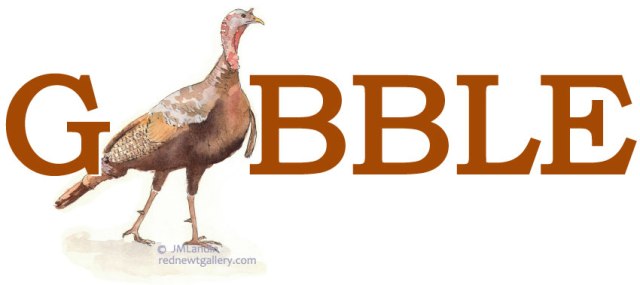
The American Thanksgiving feast is almost unimaginable today without the turkey. The bird’s name, image, and flesh have become synonymous with the annual holiday, as evident from young children’s grade-school artwork, grocery store advertisements, political ceremonies, and professional football game trophies.1 Since the turkey’s modest inception at the seventeenth-century harvest celebration of the Pilgrims and Wampanoag people, the creature’s stature has greatly ascended.
Humble Origins
For starters, whether turkey (Meleagris gallapavo) was consumed at that famous gathering of 1621 is dubious. The few records available indicate that an extensive amount of game was prepared for the three-day autumnal feast at Plymouth, Massachusetts, the event often considered the precursor of and model for our Thanksgiving holiday. First-person accounts from participants Edward Winslow and William Bradford reveal that, along with venison and fish, “fowle” / “foule” was served.2 However, experts have expressed skepticism about whether this reference meant turkeys, noting that ducks and geese were more likely due to their prevalence in that area.3, 4
Meanwhile, during the time of the harvest event at the Plymouth colony, turkeys from North America were already being consumed in England.5 Approximately a century prior to this historic celebration, European explorers had discovered the domesticated turkey in what is today Mexico. When conquering the Aztecs, the Spaniards brought these birds back along with them. Oddly enough, the fowl’s similarity to another established galliform led to its eventual namesake. “Guinea fowl, a native of Africa, was known as a turkey in some areas because some of the domesticated stock had been imported from Turkey,” explains zoologist Osmond Breland in his book Animal Life and Lore. “Out of this confusion, the American fowls were also called turkeys.”6 So this, in short, is how a New World bird acquired the name of a Middle Eastern country.
The American turkey quickly assumed its spot among prominent feast birds, eventually eclipsing them. For centuries throughout Europe, other large and more abundant fowl had adorned tables during celebratory meals and festive occasions. In England, roasted swan had been popular in such circumstances.7 Domesticated geese had been commonly used as well, especially during autumn.8 The custom of two children pulling opposite ends of the wishbone or furcula to obtain a granted wish or to determine who would be the first to marry may have even begun with the greylag goose.9 When the turkey grew in popularity, so did the transfer of this ritual. The turkey was a poultry favorite among the American colonists, though Benjamin Franklin’s letter expressing admiration for the bird as a symbol for the new country has been overstated and misunderstood.
The Dinner Table Centerpiece of a Holiday
By the nineteenth century, the turkey gained a prominent position within the Thanksgiving meal, thanks primarily to novelist and Godey’s Lady’s Book magazine editor Sarah Josepha Hale. Her efforts persuaded President Abraham Lincoln in 1863 to declare Thanksgiving a nationally recognized annual holiday; she also popularized the turkey’s culinary importance in her writings.10 Besides establishing this distinctly American celebration, President Lincoln became the first U.S. commander-in-chief to “pardon” the bird. The presidential practice of granting selected turkeys clemency from the dinner table, however, did not catch on until a century later, starting with President John F. Kennedy.11
Without the vision of Hale and the influence of Lincoln, Thanksgiving as we celebrate it today perhaps would not exist. Of course, the colloquial moniker “Turkey Day” may be an unfortunate indictment that this special occasion, established for expressing gratitude, has turned into our nation’s most gluttonous pastime.
Sources:
- “NFL Thanksgiving Day Football History, Trivia, and Fun Facts,” 11/24/10, 1/3/2015. Sports Geekery: http://www.sportsgeekery.com/3815/nfl-thanksgiving-day-football-history-and-fun-facts/.
- “Primary Sources for the ‘First Thanksgiving’ at Plymouth.” Pilgrim Hall Museum: http://www.pilgrimhallmuseum.org/pdf/TG_What_Happened_in_1621.pdf.
- Armstrong, E. “The First Thanksgiving,” 11/27/2002. The Christian Science Monitor. http://www.csmonitor.com/2002/1127/p13s02-lign.html.
- Krulwich, R. “First Thanksgiving Dinner: No Turkeys. No Ladies. No Pies,” 11/23/2011. NPR. http://www.npr.org/blogs/krulwich/2010/11/22/131516586/who-brought-the-turkey-the-truth-about-the-first-thanksgiving.
- Cocker, M., Tipling, D. Birds & People. London: Jonathan Cape, Random House, 2013. p. 44.
- Breland, OP. Animal Life and Lore: Revised Edition. New York: Harper & Row Publishers, 1972. p. 148.
- Cocker, M., Tipling, D. p. 44.
- Weidensaul, S. The Birder’s Miscellany: A Fascinating Collection of Facts, Figures, and Folklore from the World of Birds. New York: Simon & Schuster Inc., 1991. p. 93.
- Lederer, R. Amazing Birds: A Treasury of Facts and Trivia about the Avian World. London: Quarto Publishing, 2007. p. 104.
- Krulwich, R.
- Montanaro, D. “The Strange Truth Behind Presidential Turkey Pardons,” 11/25/2015. NPR: http://www.npr.org/2015/11/25/457253194/the-strange-truth-behind-presidential-turkey-pardons.
